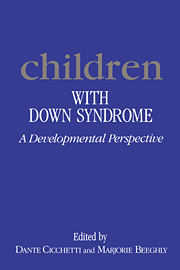Book contents
- Frontmatter
- Contents
- List of contributors
- Preface
- 1 Applying the developmental perspective to individuals with Down syndrome
- 2 An organizational approach to the study of Down syndrome: contributions to an integrative theory of development
- 3 Temperament and Down syndrome
- 4 Interactions between parents and their infants with Down syndrome
- 5 Attention, memory, and perception in infants with Down syndrome: a review and commentary
- 6 Sensorimotor development of infants with Down syndrome
- 7 The growth of self-monitoring among young children with Down syndrome
- 8 Early conceptual development of children with Down syndrome
- 9 Language abilities in children with Down syndrome: evidence for a specific syntactic delay
- 10 Beyond sensorimotor functioning: early communicative and play development of children with Down syndrome
- 11 Peer relations of children with Down syndrome
- 12 Families of children with Down syndrome: ecological contexts and characteristics
- 13 Early intervention from a developmental perspective
- Name index
- Subject index
5 - Attention, memory, and perception in infants with Down syndrome: a review and commentary
Published online by Cambridge University Press: 02 November 2009
- Frontmatter
- Contents
- List of contributors
- Preface
- 1 Applying the developmental perspective to individuals with Down syndrome
- 2 An organizational approach to the study of Down syndrome: contributions to an integrative theory of development
- 3 Temperament and Down syndrome
- 4 Interactions between parents and their infants with Down syndrome
- 5 Attention, memory, and perception in infants with Down syndrome: a review and commentary
- 6 Sensorimotor development of infants with Down syndrome
- 7 The growth of self-monitoring among young children with Down syndrome
- 8 Early conceptual development of children with Down syndrome
- 9 Language abilities in children with Down syndrome: evidence for a specific syntactic delay
- 10 Beyond sensorimotor functioning: early communicative and play development of children with Down syndrome
- 11 Peer relations of children with Down syndrome
- 12 Families of children with Down syndrome: ecological contexts and characteristics
- 13 Early intervention from a developmental perspective
- Name index
- Subject index
Summary
In recent years, interest in the development of perceptual, memory, and attentional processes in infants and children has burgeoned. A great deal of this work has been spurred by technological advances and by the development of new experimental paradigms that have made it possible to explore infants' abilities and limitations in these areas (Cicchetti & Wagner, in press). Such research has underscored the importance of examining these basic capacities in elucidating how individuals perceive and understand their world. As a result, our knowledge of the processes and mechanisms that underlie cognitive development during these periods has increased dramatically.
In this chapter, we focus upon perception, attention, and memory in infants and children with Down syndrome. Consequently, we review studies that have utilized nontraditional assessments of these abilities. We have adopted a developmental framework in our discussion of these abilities because we are interested in the ontogenesis and interactions of psychological processes over developmental time. Historically, most of the previous reviews and research on Down syndrome has been characterized by an a-developmental approach. In general, Down syndrome samples and normal or other mentally retarded groups of similar mental or chronological age have been compared at a single point in time. True developmental studies have been infrequently conducted because it is difficult to collect data from sufficient numbers of children with Down syndrome at several different ages and to examine them longitudinally. Additionally, another difficulty in longitudinal studies with this population resides in the controls: Over time normal controls become inappropriate owing to their accelerated rate of development.
- Type
- Chapter
- Information
- Children with Down SyndromeA Developmental Perspective, pp. 147 - 179Publisher: Cambridge University PressPrint publication year: 1990
- 11
- Cited by

